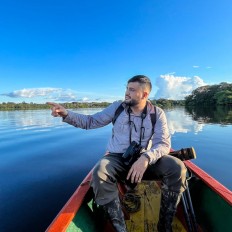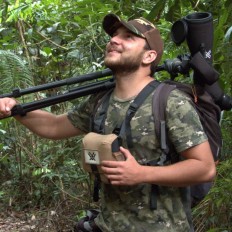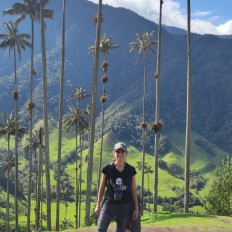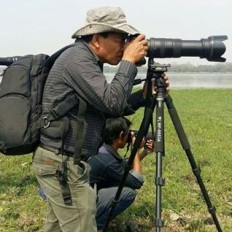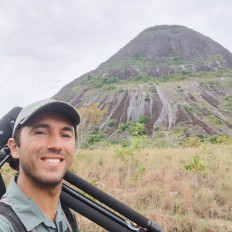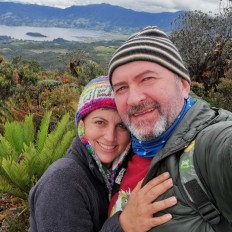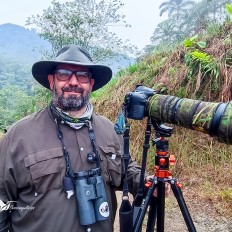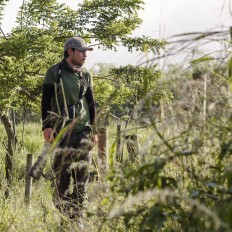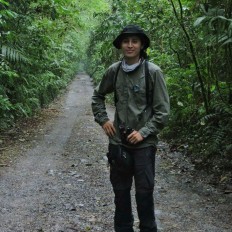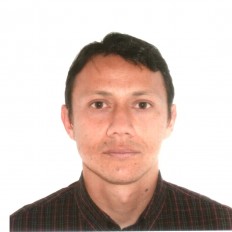Birdwatching is mainly along an 11 km unpaved road that leads from the town of La Florida (1700 masl) to a sector known as El Cedral - PRN Ucumarí (2100 masl, 4°42'14.767"N, 75°32'14.776"W) where the road for cars ends. SFF Otún Quimbaya is located in the middle of this route (1900 masl, 4°43'43.628"N, 75°34'39.866"W), approx. 5km from Florida Town (1700 mals 4°45'33.244"N, 75°36'42.481"W). At this point we find the lodge with restaurant and lodging services with prior reservation, there are also some trails within the forest that offer to be traveled.
In the first 2-3 kilometers and along the road after the Florida Town on the road to SFF Lodge is possible to find species from cultivated areas and secondary forests. Some seedeaters are farily common in the first kilometer, as: Blue-black Grassquit (Volatinia jacarina), Yellow-faced Grassquit (Tiaris olivaceus), Gray Seedeater (Sporophila intermedia) & Saffron Finch (Sicalis flaveola). Also in the bushes it is possible the Green Jay (Cyanocorax yncas), the endemic Parker's Antbird (Cercomacroides parkeri), Andean Motmot (Momotus aequatorialis), & Three-striped Warbler (Basileuterus tristriatus).
As in most places in the Andes, the first hours of the morning have the greatest bird activity. In the first 2-3,5 kilometers and along the road after the Lodge on the road to El Cedral - PRN Ucumarí, Cauca Guan and Red-ruffed Fruitcrow are very common and easy to find, it is a matter of following the road carefully so that at some point you will see them.
It is recommended to do it walking because it is also possible to find mixed flocks with cool birs as:
Tanagers: Multicolored Tanager (Chlorochrysa nitidissima), Metallic-green (Tangara labradorides), Golden-naped (Chalcothraupis ruficervix), Golden (Tangara arthus) and Saffron-crowned (Tangara xanthocephala) are possible too.
Flycactchers: Variegated Bristle-tyrant (Pogonotriccus poecilotis), Rufous-breasted Flycatcher (Leptopogon rufipectus), Plumbeous-crowned Tyrannulet (Phyllomyias plumbeiceps), Ashy-headed Tyrannulet (Phyllomyias cinereiceps),
Furnadirs: Rusty winged Barbtail (Premnornis guttuliger), Strong-billed Woodcreeper (Xiphocolaptes promeropirhynchus).
Woodpeckers: Golden-olive Woodpecker (Colaptes rubiginosus) and Powerful Woodpecker (Campephilus pollens).
Another recommendation is to access the bridges (1st Bridge: 4°44'46.886"N, 75°36'12.927"W - 2d Bridge: 4°43'51.043"N, 75°34'37.061"W - 3rd Bridge: 4°42'11.594"N, 75°32'12.253"W, near El Cedral) and viewpoints that you find over the Otún river that runs parallel to the road, because that is where you have the possibility to connect with Torrent Duck (Merganetta armata), White-capped Dipper (Cinclus leucocephalus), Torrent Tyrannulet (Serpophaga cinerea) & Black Phoebe (Sayornis nigricans).
Check the small creeks that you find along the road because there it is possible to find Green-fronted Lancebill (Doryfera ludovicae) perched and hunting insects.
Other possible species are: Golden-plumed Parakeet (Leptosittaca branicki), Collared Trogon (Trogon collaris), Bronze-winged Parrot (Pionus chalcopterus), White-throated Daggerbill (Schistes albogularis), Wattled Guan (Aburria aburri), Golden-headed Quetzal (Pharomachrus auriceps) not common, Stile's Tapaculo (Scytalopus stilesi), Pale-eyed Thrush (Turdus leucops), Black-billed Peppershrike (Cyclarhis nigrirostris), White-naped Brush-Finch (Atlapetes albinucha), Black-winged Saltator (Saltator atripennis), Flame-rumped Tanager (Ramphocelus flammigerus).
During migration season (april-september) it is possible: Broad-winged Hawk (Buteo platypterus), Blackburnian Warbler (Setophaga fusca), Swainson's Thrush (Catharus ustulatus), Summer Tanager (Piranga rubra), Cerulean Warbler (Setophaga cerulea) uncommon & Golden-winged Warbler (Vermivora chrysoptera) rare.
About raptors: Some reported species are Black-and-chestnut Eagle (Spizaetus isidori), Collared (Micrastur semitorquatus) and Barred (Micrastur ruficollis) Forest-Falcons, however they are not common or easy to find, but still possible.
At the end of the road you will find the point known as El Cedral - PRN Ucumarí, there are a couple of houses, with a store and one of them offers lodging and food service, as well as bathrooms (Cabaña El Cedral. +57 3235091882 or email: reservaselcedral@gmail.com). This site is very good to look for in the morning the very rare and local Hooded Antpitta (Grallaricula cucullata), Moustached Antpitta (Grallaria alleni) & Chestnut-breasted Wren (Cyphorhinus thoracicus) is frequently heard at this point. It is also possible White-capped Tanager (Sericossypha albocristata) that moves in family and noisy flocks.
It is highly recommended to do the night tour to look for species such as: Rufescent Screech-Owl (Megascops ingens) common near SFF Otún Quimbaya Lodge, Tropical Screech-Owl (Megascops choliba), Mottled Owl (Strix virgata) and Black-and-white Owl (Strix nigrolineata) are possible along the road. Also you have chances of Rufous-bellied Nighthawk (Lurocalis rufiventris), it is recommended to look for it at sunset when it goes out to fly over the most open areas around the lodge.
Here the hotspots on ebird to check about the birds:
1. SFF Otún Quimbaya - https://ebird.org/hotspot/L1433708
2. El Cedral - PRN Ucumarí - https://ebird.org/hotspot/L2638098
Birdwatching is mainly along an 11 km unpaved road that leads from the town of La Florida (1700 masl) to a sector known as El Cedral - PRN Ucumarí (2100 masl, 4°42'14.767"N, 75°32'14.776"W) where the road for cars ends. SFF Otún Quimbaya is located in the middle of this route (1900 masl, 4°43'43.628"N, 75°34'39.866"W), approx. 5km from Florida Town (1700 mals 4°45'33.244"N, 75°36'42.481"W). At this point we find the lodge with restaurant and lodging services with prior reservation, there are also some trails within the forest that offer to be traveled.
In the first 2-3 kilometers and along the road after the Florida Town on the road to SFF Lodge is possible to find species from cultivated areas and secondary forests. Some seedeaters are farily common in the first kilometer, as: Blue-black Grassquit (Volatinia jacarina), Yellow-faced Grassquit (Tiaris olivaceus), Gray Seedeater (Sporophila intermedia) & Saffron Finch (Sicalis flaveola). Also in the bushes it is possible the Green Jay (Cyanocorax yncas), the endemic Parker's Antbird (Cercomacroides parkeri), Andean Motmot (Momotus aequatorialis), & Three-striped Warbler (Basileuterus tristriatus).
As in most places in the Andes, the first hours of the morning have the greatest bird activity. In the first 2-3,5 kilometers and along the road after the Lodge on the road to El Cedral - PRN Ucumarí, Cauca Guan and Red-ruffed Fruitcrow are very common and easy to find, it is a matter of following the road carefully so that at some point you will see them.
It is recommended to do it walking because it is also possible to find mixed flocks with cool birs as:
Tanagers: Multicolored Tanager (Chlorochrysa nitidissima), Metallic-green (Tangara labradorides), Golden-naped (Chalcothraupis ruficervix), Golden (Tangara arthus) and Saffron-crowned (Tangara xanthocephala) are possible too.
Flycactchers: Variegated Bristle-tyrant (Pogonotriccus poecilotis), Rufous-breasted Flycatcher (Leptopogon rufipectus), Plumbeous-crowned Tyrannulet (Phyllomyias plumbeiceps), Ashy-headed Tyrannulet (Phyllomyias cinereiceps),
Furnadirs: Rusty winged Barbtail (Premnornis guttuliger), Strong-billed Woodcreeper (Xiphocolaptes promeropirhynchus).
Woodpeckers: Golden-olive Woodpecker (Colaptes rubiginosus) and Powerful Woodpecker (Campephilus pollens).
Another recommendation is to access the bridges (1st Bridge: 4°44'46.886"N, 75°36'12.927"W - 2d Bridge: 4°43'51.043"N, 75°34'37.061"W - 3rd Bridge: 4°42'11.594"N, 75°32'12.253"W, near El Cedral) and viewpoints that you find over the Otún river that runs parallel to the road, because that is where you have the possibility to connect with Torrent Duck (Merganetta armata), White-capped Dipper (Cinclus leucocephalus), Torrent Tyrannulet (Serpophaga cinerea) & Black Phoebe (Sayornis nigricans).
Check the small creeks that you find along the road because there it is possible to find Green-fronted Lancebill (Doryfera ludovicae) perched and hunting insects.
Other possible species are: Golden-plumed Parakeet (Leptosittaca branicki), Collared Trogon (Trogon collaris), Bronze-winged Parrot (Pionus chalcopterus), White-throated Daggerbill (Schistes albogularis), Wattled Guan (Aburria aburri), Golden-headed Quetzal (Pharomachrus auriceps) not common, Stile's Tapaculo (Scytalopus stilesi), Pale-eyed Thrush (Turdus leucops), Black-billed Peppershrike (Cyclarhis nigrirostris), White-naped Brush-Finch (Atlapetes albinucha), Black-winged Saltator (Saltator atripennis), Flame-rumped Tanager (Ramphocelus flammigerus).
During migration season (april-september) it is possible: Broad-winged Hawk (Buteo platypterus), Blackburnian Warbler (Setophaga fusca), Swainson's Thrush (Catharus ustulatus), Summer Tanager (Piranga rubra), Cerulean Warbler (Setophaga cerulea) uncommon & Golden-winged Warbler (Vermivora chrysoptera) rare.
About raptors: Some reported species are Black-and-chestnut Eagle (Spizaetus isidori), Collared (Micrastur semitorquatus) and Barred (Micrastur ruficollis) Forest-Falcons, however they are not common or easy to find, but still possible.
At the end of the road you will find the point known as El Cedral - PRN Ucumarí, there are a couple of houses, with a store and one of them offers lodging and food service, as well as bathrooms (Cabaña El Cedral. +57 3235091882 or email: reservaselcedral@gmail.com). This site is very good to look for in the morning the very rare and local Hooded Antpitta (Grallaricula cucullata), Moustached Antpitta (Grallaria alleni) & Chestnut-breasted Wren (Cyphorhinus thoracicus) is frequently heard at this point. It is also possible White-capped Tanager (Sericossypha albocristata) that moves in family and noisy flocks.
It is highly recommended to do the night tour to look for species such as: Rufescent Screech-Owl (Megascops ingens) common near SFF Otún Quimbaya Lodge, Tropical Screech-Owl (Megascops choliba), Mottled Owl (Strix virgata) and Black-and-white Owl (Strix nigrolineata) are possible along the road. Also you have chances of Rufous-bellied Nighthawk (Lurocalis rufiventris), it is recommended to look for it at sunset when it goes out to fly over the most open areas around the lodge.
Here the hotspots on ebird to check about the birds:
1. SFF Otún Quimbaya - https://ebird.org/hotspot/L1433708
2. El Cedral - PRN Ucumarí - https://ebird.org/hotspot/L2638098
Birdwatching is mainly along an 11 km unpaved road that leads from the town of La Florida (1700 masl) to a sector known as El Cedral - PRN Ucumarí (2100 masl, 4°42'14.767"N, 75°32'14.776"W) where the road for cars ends. SFF Otún Quimbaya is located in the middle of this route (1900 masl, 4°43'43.628"N, 75°34'39.866"W), approx. 5km from Florida Town (1700 mals 4°45'33.244"N, 75°36'42.481"W). At this point we find the lodge with restaurant and lodging services with prior reservation, there are also some trails within the forest that offer to be traveled.
In the first 2-3 kilometers and along the road after the Florida Town on the road to SFF Lodge is possible to find species from cultivated areas and secondary forests. Some seedeaters are farily common in the first kilometer, as: Blue-black Grassquit (Volatinia jacarina), Yellow-faced Grassquit (Tiaris olivaceus), Gray Seedeater (Sporophila intermedia) & Saffron Finch (Sicalis flaveola). Also in the bushes it is possible the Green Jay (Cyanocorax yncas), the endemic Parker's Antbird (Cercomacroides parkeri), Andean Motmot (Momotus aequatorialis), & Three-striped Warbler (Basileuterus tristriatus).
As in most places in the Andes, the first hours of the morning have the greatest bird activity. In the first 2-3,5 kilometers and along the road after the Lodge on the road to El Cedral - PRN Ucumarí, Cauca Guan and Red-ruffed Fruitcrow are very common and easy to find, it is a matter of following the road carefully so that at some point you will see them.
It is recommended to do it walking because it is also possible to find mixed flocks with cool birs as:
Tanagers: Multicolored Tanager (Chlorochrysa nitidissima), Metallic-green (Tangara labradorides), Golden-naped (Chalcothraupis ruficervix), Golden (Tangara arthus) and Saffron-crowned (Tangara xanthocephala) are possible too.
Flycactchers: Variegated Bristle-tyrant (Pogonotriccus poecilotis), Rufous-breasted Flycatcher (Leptopogon rufipectus), Plumbeous-crowned Tyrannulet (Phyllomyias plumbeiceps), Ashy-headed Tyrannulet (Phyllomyias cinereiceps),
Furnadirs: Rusty winged Barbtail (Premnornis guttuliger), Strong-billed Woodcreeper (Xiphocolaptes promeropirhynchus).
Woodpeckers: Golden-olive Woodpecker (Colaptes rubiginosus) and Powerful Woodpecker (Campephilus pollens).
Another recommendation is to access the bridges (1st Bridge: 4°44'46.886"N, 75°36'12.927"W - 2d Bridge: 4°43'51.043"N, 75°34'37.061"W - 3rd Bridge: 4°42'11.594"N, 75°32'12.253"W, near El Cedral) and viewpoints that you find over the Otún river that runs parallel to the road, because that is where you have the possibility to connect with Torrent Duck (Merganetta armata), White-capped Dipper (Cinclus leucocephalus), Torrent Tyrannulet (Serpophaga cinerea) & Black Phoebe (Sayornis nigricans).
Check the small creeks that you find along the road because there it is possible to find Green-fronted Lancebill (Doryfera ludovicae) perched and hunting insects.
Other possible species are: Golden-plumed Parakeet (Leptosittaca branicki), Collared Trogon (Trogon collaris), Bronze-winged Parrot (Pionus chalcopterus), White-throated Daggerbill (Schistes albogularis), Wattled Guan (Aburria aburri), Golden-headed Quetzal (Pharomachrus auriceps) not common, Stile's Tapaculo (Scytalopus stilesi), Pale-eyed Thrush (Turdus leucops), Black-billed Peppershrike (Cyclarhis nigrirostris), White-naped Brush-Finch (Atlapetes albinucha), Black-winged Saltator (Saltator atripennis), Flame-rumped Tanager (Ramphocelus flammigerus).
During migration season (april-september) it is possible: Broad-winged Hawk (Buteo platypterus), Blackburnian Warbler (Setophaga fusca), Swainson's Thrush (Catharus ustulatus), Summer Tanager (Piranga rubra), Cerulean Warbler (Setophaga cerulea) uncommon & Golden-winged Warbler (Vermivora chrysoptera) rare.
About raptors: Some reported species are Black-and-chestnut Eagle (Spizaetus isidori), Collared (Micrastur semitorquatus) and Barred (Micrastur ruficollis) Forest-Falcons, however they are not common or easy to find, but still possible.
At the end of the road you will find the point known as El Cedral - PRN Ucumarí, there are a couple of houses, with a store and one of them offers lodging and food service, as well as bathrooms (Cabaña El Cedral. +57 3235091882 or email: reservaselcedral@gmail.com). This site is very good to look for in the morning the very rare and local Hooded Antpitta (Grallaricula cucullata), Moustached Antpitta (Grallaria alleni) & Chestnut-breasted Wren (Cyphorhinus thoracicus) is frequently heard at this point. It is also possible White-capped Tanager (Sericossypha albocristata) that moves in family and noisy flocks.
It is highly recommended to do the night tour to look for species such as: Rufescent Screech-Owl (Megascops ingens) common near SFF Otún Quimbaya Lodge, Tropical Screech-Owl (Megascops choliba), Mottled Owl (Strix virgata) and Black-and-white Owl (Strix nigrolineata) are possible along the road. Also you have chances of Rufous-bellied Nighthawk (Lurocalis rufiventris), it is recommended to look for it at sunset when it goes out to fly over the most open areas around the lodge.
Birdwatching is mainly along an 11 km unpaved road that leads from the town of La Florida (1700 masl) to a sector known as El Cedral - PRN Ucumarí (2100 masl, 4°42'14.767"N, 75°32'14.776"W) where the road for cars ends. SFF Otún Quimbaya is located in the middle of this route (1900 masl, 4°43'43.628"N, 75°34'39.866"W), approx. 5km from Florida Town (1700 mals 4°45'33.244"N, 75°36'42.481"W). At this point we find the lodge with restaurant and lodging services with prior reservation, there are also some trails within the forest that offer to be traveled.
In the first 2-3 kilometers and along the road after the Florida Town on the road to SFF Lodge is possible to find species from cultivated areas and secondary forests. Some seedeaters are farily common in the first kilometer, as: Blue-black Grassquit (Volatinia jacarina), Yellow-faced Grassquit (Tiaris olivaceus), Gray Seedeater (Sporophila intermedia) & Saffron Finch (Sicalis flaveola). Also in the bushes it is possible the Green Jay (Cyanocorax yncas), the endemic Parker's Antbird (Cercomacroides parkeri), Andean Motmot (Momotus aequatorialis), & Three-striped Warbler (Basileuterus tristriatus).
As in most places in the Andes, the first hours of the morning have the greatest bird activity. In the first 2-3,5 kilometers and along the road after the Lodge on the road to El Cedral - PRN Ucumarí, Cauca Guan and Red-ruffed Fruitcrow are very common and easy to find, it is a matter of following the road carefully so that at some point you will see them.
It is recommended to do it walking because it is also possible to find mixed flocks with cool birs as:
Tanagers: Multicolored Tanager (Chlorochrysa nitidissima), Metallic-green (Tangara labradorides), Golden-naped (Chalcothraupis ruficervix), Golden (Tangara arthus) and Saffron-crowned (Tangara xanthocephala) are possible too.
Flycactchers: Variegated Bristle-tyrant (Pogonotriccus poecilotis), Rufous-breasted Flycatcher (Leptopogon rufipectus), Plumbeous-crowned Tyrannulet (Phyllomyias plumbeiceps), Ashy-headed Tyrannulet (Phyllomyias cinereiceps),
Furnadirs: Rusty winged Barbtail (Premnornis guttuliger), Strong-billed Woodcreeper (Xiphocolaptes promeropirhynchus).
Woodpeckers: Golden-olive Woodpecker (Colaptes rubiginosus) and Powerful Woodpecker (Campephilus pollens).
Another recommendation is to access the bridges (1st Bridge: 4°44'46.886"N, 75°36'12.927"W - 2d Bridge: 4°43'51.043"N, 75°34'37.061"W - 3rd Bridge: 4°42'11.594"N, 75°32'12.253"W, near El Cedral) and viewpoints that you find over the Otún river that runs parallel to the road, because that is where you have the possibility to connect with Torrent Duck (Merganetta armata), White-capped Dipper (Cinclus leucocephalus), Torrent Tyrannulet (Serpophaga cinerea) & Black Phoebe (Sayornis nigricans).
Check the small creeks that you find along the road because there it is possible to find Green-fronted Lancebill (Doryfera ludovicae) perched and hunting insects.
Other possible species are: Golden-plumed Parakeet (Leptosittaca branicki), Collared Trogon (Trogon collaris), Bronze-winged Parrot (Pionus chalcopterus), White-throated Daggerbill (Schistes albogularis), Wattled Guan (Aburria aburri), Golden-headed Quetzal (Pharomachrus auriceps) not common, Stile's Tapaculo (Scytalopus stilesi), Pale-eyed Thrush (Turdus leucops), Black-billed Peppershrike (Cyclarhis nigrirostris), White-naped Brush-Finch (Atlapetes albinucha), Black-winged Saltator (Saltator atripennis), Flame-rumped Tanager (Ramphocelus flammigerus).
During migration season (april-september) it is possible: Broad-winged Hawk (Buteo platypterus), Blackburnian Warbler (Setophaga fusca), Swainson's Thrush (Catharus ustulatus), Summer Tanager (Piranga rubra), Cerulean Warbler (Setophaga cerulea) uncommon & Golden-winged Warbler (Vermivora chrysoptera) rare.
About raptors: Some reported species are Black-and-chestnut Eagle (Spizaetus isidori), Collared (Micrastur semitorquatus) and Barred (Micrastur ruficollis) Forest-Falcons, however they are not common or easy to find, however they are but still possible.
At the end of the road you will find the point known as El Cedral - PRN Ucumarí, there are a couple of houses, with a store and one of them offers lodging and food service, as well as bathrooms.bathrooms (Cabaña El Cedral. +57 3235091882 or email: reservaselcedral@gmail.com). This site is very good to look for in the morning the very rare and local Hooded Antpitta (Grallaricula cucullata), Moustached Antpitta (Grallaria alleni) & Chestnut-breasted Wren (Cyphorhinus thoracicus) is frequently heard at this point. It is also possible White-capped Tanager (Sericossypha albocristata) that moves in family and noisy flocks.
Birdwatching is mainly along an 11 km unpaved road that leads from the town of La Florida (1700 masl) to a sector known as El Cedral - PRN Ucumarí (2100 masl, 4°42'14.767"N, 75°32'14.776"W) where the road for cars ends. SFF Otún Quimbaya is located in the middle of this route (1900 masl, 4°43'43.628"N, 75°34'39.866"W), approx. 5km from Florida Town (1700 mals 4°45'33.244"N, 75°36'42.481"W). At this point we find the lodge with restaurant and lodging services with prior reservation, there are also some trails within the forest that offer to be traveled.
In the first 2-3 kilometers and along the road after the Florida Town on the road to SFF Lodge is possible to find species from cultivated areas and secondary forests. Some seedeaters are farily common in the first kilometer, as: Blue-black Grassquit (Volatinia jacarina), Yellow-faced Grassquit (Tiaris olivaceus), Gray Seedeater (Sporophila intermedia) & Saffron Finch (Sicalis flaveola). Also in the bushes it is possible the Green Jay (Cyanocorax yncas), the endemic Parker's Antbird (Cercomacroides parkeri), Andean Motmot (Momotus aequatorialis), & Three-striped Warbler (Basileuterus tristriatus).
As in most places in the Andes, the first hours of the morning have the greatest bird activity. In the first 2-3,5 kilometers and along the road after the Lodge on the road to El Cedral - PRN Ucumarí, Cauca Guan and Red-ruffed Fruitcrow are very common and easy to find, it is a matter of following the road carefully so that at some point you will see them.
It is recommended to do it walking because it is also possible to find mixed flocks with cool birs as:
Tanagers: Multicolored Tanager (Chlorochrysa nitidissima), Metallic-green (Tangara labradorides), Golden-naped (Chalcothraupis ruficervix), Golden (Tangara arthus) and Saffron-crowned (Tangara xanthocephala) are possible too.
Flycactchers: Variegated Bristle-tyrant (Pogonotriccus poecilotis), Rufous-breasted Flycatcher (Leptopogon rufipectus), Plumbeous-crowned Tyrannulet (Phyllomyias plumbeiceps), Ashy-headed Tyrannulet (Phyllomyias cinereiceps),
Furnadirs: Rusty winged Barbtail (Premnornis guttuliger), Strong-billed Woodcreeper (Xiphocolaptes promeropirhynchus).
Woodpeckers: Golden-olive Woodpecker (Colaptes rubiginosus) and Powerful Woodpecker (Campephilus pollens).
Another recommendation is to access the bridges (1st Bridge: 4°44'46.886"N, 75°36'12.927"W - 2d Bridge: 4°43'51.043"N, 75°34'37.061"W - 3rd Bridge: 4°42'11.594"N, 75°32'12.253"W, near El Cedral) and viewpoints that you find over the Otún river that runs parallel to the road, because that is where you have the possibility to connect with Torrent Duck (Merganetta armata), White-capped Dipper (Cinclus leucocephalus), Torrent Tyrannulet (Serpophaga cinerea) & Black Phoebe (Sayornis nigricans).
Check the small creeks that you find along the road because there it is possible to find Green-fronted Lancebill (Doryfera ludovicae) perched and hunting insects.
Other possible species are: Golden-plumed Parakeet (Leptosittaca branicki), Collared Trogon (Trogon collaris), Bronze-winged Parrot (Pionus chalcopterus), White-throated Daggerbill (Schistes albogularis), Wattled Guan (Aburria aburri), Golden-headed Quetzal (Pharomachrus auriceps) not common, Stile's Tapaculo (Scytalopus stilesi), Pale-eyed Thrush (Turdus leucops), Black-billed Peppershrike (Cyclarhis nigrirostris), White-naped Brush-Finch (Atlapetes albinucha), Black-winged Saltator (Saltator atripennis), Flame-rumped Tanager (Ramphocelus flammigerus).
During migration season (april-september) it is possible: Broad-winged Hawk (Buteo platypterus), Blackburnian Warbler (Setophaga fusca), Swainson's Thrush (Catharus ustulatus), Summer Tanager (Piranga rubra), Cerulean Warbler (Setophaga cerulea) uncommon & Golden-winged Warbler (Vermivora chrysoptera) rare.
About raptors: Some reported species are Black-and-chestnut Eagle (Spizaetus isidori), Collared (Micrastur semitorquatus) and Barred (Micrastur ruficollis) Forest-Falcons, however they are not common or easy to find, however they are possible.
At the end of the road you will find the point known as El Cedral - PRN Ucumarí, there are a couple of houses, with a store and one of them offers lodging and food service, as well as bathrooms. This site is very good to look for in the morning the very rare and local Hooded Antpitta (Grallaricula cucullata), Moustached Antpitta (Grallaria alleni) & Chestnut-breasted Wren (Cyphorhinus thoracicus) is frequently heard at this point. It is also possible White-capped Tanager (Sericossypha albocristata) that moves in family and noisy flocks.
An important fact is that El Cedral - PRN Ucumarí is a great spot place to connect with Mountain Tapir (Tapirus pinchaque), several individuals frequent the area and are active at dawn, dusk and at night; therefore, if you stay a couple of nights you will have a good chance of seeing one.
Birdwatching is mainly along an 11 km unpaved road that leads from the town of La Florida (1700 masl) to a sector known as El Cedral - PRN Ucumarí (2100 masl, 4°42'14.767"N, 75°32'14.776"W) where the road for cars ends. SFF Otún Quimbaya is located in the middle of this route (1900 masl, 4°43'43.628"N, 75°34'39.866"W), approx. 5km from Florida Town (1700 mals 4°45'33.244"N, 75°36'42.481"W). At this point we find the lodge with restaurant and lodging services with prior reservation, there are also some trails within the forest that offer to be traveled.
In the first 2-3 kilometers and along the road after the Florida Town on the road to SFF Lodge is possible to find species from cultivated areas and secondary forests. Some seedeaters are farily common in the first kilometer, as: Blue-black Grassquit (Volatinia jacarina), Yellow-faced Grassquit (Tiaris olivaceus), Gray Seedeater (Sporophila intermedia) & Saffron Finch (Sicalis flaveola). Also in the bushes it is possible the Green Jay (Cyanocorax yncas), the endemic Parker's Antbird (Cercomacroides parkeri), Andean Motmot (Momotus aequatorialis), & Three-striped Warbler (Basileuterus tristriatus).
As in most places in the Andes, the first hours of the morning have the greatest bird activity. In the first 2-3,5 kilometers and along the road after the Lodge on the road to El Cedral - PRN Ucumarí, Cauca Guan and Red-ruffed Fruitcrow are very common and easy to find, it is a matter of following the road carefully so that at some point you will see them.
It is recommended to do it walking because it is also possible to find mixed flocks with cool birs as:
Tanagers: Multicolored Tanager (Chlorochrysa nitidissima), Metallic-green (Tangara labradorides),
rides), labradorides), Golden-naped (Chalcothraupis ruficervix), Golden (Tangara arthus) and Saffron-crowned (Tangara xanthocephala) are possible too.
Flycactchers: Variegated Bristle-tyrant (Pogonotriccus poecilotis), Rufous-breasted Flycatcher (Leptopogon rufipectus), Plumbeous-crowned Tyrannulet (Phyllomyias plumbeiceps), Ashy-headed Tyrannulet (Phyllomyias cinereiceps),
Furnadirs: Rusty winged Barbtail (Premnornis guttuliger), Strong-billed Woodcreeper (Xiphocolaptes Strong-billed Woodcreeper (Xiphocolaptes promeropirhynchus).
Woodpeckers: Golden-olive Woodpecker (Colaptes rubiginosus) and Powerful Woodpecker (Campephilus pollens).
Another recommendation is to access the bridges (1st Bridge: 4°44'46.886"N, 75°36'12.927"W - 2d Bridge: 4°43'51.043"N, 75°34'37.061"W - 3rd Bridge: 4°42'11.594"N, 75°32'12.253"W, near El Cedral) and viewpoints that you find over the Otún river that runs parallel to the road, because that is where you have the possibility to connect with Torrent Duck (Merganetta armata), White-capped Dipper (Cinclus leucocephalus), Torrent Tyrannulet (Serpophaga cinerea) & Black Phoebe (Sayornis nigricans).
Check the small creeks that you find along the road because there it is possible to find Green-fronted Lancebill (Doryfera ludovicae) perched and hunting insects.
Other possible species are: Golden-plumed Parakeet (Leptosittaca branicki), Collared Trogon (Trogon collaris), Bronze-winged Parrot (Pionus chalcopterus), White-throated Daggerbill (Schistes albogularis), Wattled Guan (Aburria aburri), Golden-headed Quetzal (Pharomachrus auriceps) not common, Stile's Tapaculo (Scytalopus stilesi), Pale-eyed Thrush (Turdus leucops), Black-billed Peppershrike (Cyclarhis nigrirostris), White-naped Brush-Finch (Atlapetes albinucha), Black-winged Saltator (Saltator atripennis), Flame-rumped Tanager (Ramphocelus flammigerus).
During migration season (april-september) it is possible: Broad-winged Hawk (Buteo platypterus), Blackburnian Warbler (Setophaga fusca), Swainson's Thrush (Catharus ustulatus), Summer Tanager (Piranga rubra), Cerulean Warbler (Setophaga cerulea) uncommon & Golden-winged Warbler (Vermivora chrysoptera) rare.
About raptors: Some reported species are Black-and-chestnut Eagle (Spizaetus isidori), Collared (Micrastur semitorquatus) and Barred (Micrastur ruficollis) Forest-Falcons, however they are not common or easy to find, however they are possible.
At the end of the road you will find the point known as El Cedral - PRN Ucumarí, there are a couple of houses, with a store and one of them offers lodging and food service, as well as bathrooms. This site is very good to look for in the morning the very rare and local Hooded Antpitta (Grallaricula cucullata), Moustached Antpitta (Grallaria alleni) & Chestnut-breasted Wren (Cyphorhinus thoracicus) is frequently heard at this point. It is also possible White-capped Tanager (Sericossypha albocristata) that moves in family and noisy flocks.
An important fact is that El Cedral - PRN Ucumarí is a great spot place to connect with Mountain Tapir (Tapirus pinchaque), several individuals frequent the area and are active at dawn, dusk and at night; therefore, if you stay a couple of nights you will have a good chance of seeing one.
Birdwatching is mainly along an 11 km unpaved road that leads from the town of La Florida (1700 masl) to a sector known as El Cedral (2100 - PRN Ucumarí (2100 masl, 4°42'14.767"N, 75°32'14.776"W) where the road for cars ends. SFF Otún Quimbaya is located in the middle of this route (1900 masl, 4°43'43.628"N, 75°34'39.866"W), approx. 5km from Florida Town (1700 mals 4°45'33.244"N, 75°36'42.481"W). At this point we find the lodge with restaurant and lodging services with prior reservation, there are also some trails within the forest that offer to be traveled.
In the first 2-3 kilometers and along the road after the Florida Town on the road to SFF Lodge is possible to find species from cultivated areas and secondary forests. Some seedeaters are farily common in the first kilometer, as: Blue-black Grassquit (Volatinia jacarina), Yellow-faced Grassquit (Tiaris olivaceus), Gray Seedeater (Sporophila intermedia) & Saffron Finch (Sicalis flaveola). Also in the bushes it is possible the Green Jay (Cyanocorax yncas), the endemic Parker's Antbird (Cercomacroides parkeri), Andean Motmot (Momotus aequatorialis), & Three-striped Warbler (Basileuterus tristriatus).
As in most places in the Andes, the first hours of the morning have the greatest bird activity. In the first 2-3,5 kilometers and along the road after the Lodge on the road to El Cedral, Cedral - PRN Ucumarí, Cauca Guan and Red-ruffed Fruitcrow are very common and easy to find, it is a matter of following the road carefully so that at some point you will see them.
It is recommended to do it walking because it is also possible to find mixed flocks with cool birs as:
Tanagers: Multicolored Tanager (Chlorochrysa nitidissima), Metallic-green (Tangara labradorides),
rides), Golden-naped (Chalcothraupis ruficervix), Golden (Tangara arthus) and Saffron-crowned (Tangara xanthocephala) are possible too.
Flycactchers: Variegated Bristle-tyrant (Pogonotriccus poecilotis), Rufous-breasted Flycatcher (Leptopogon rufipectus), Plumbeous-crowned Tyrannulet (Phyllomyias plumbeiceps), Ashy-headed Tyrannulet (Phyllomyias cinereiceps),
Furnadirs: Rusty winged Barbtail (Premnornis guttuliger), Strong-billed Woodcreeper (Xiphocolaptes promeropirhynchus).
Woodpeckers: Golden-olive Woodpecker (Colaptes rubiginosus) and Powerful Woodpecker (Campephilus pollens).
Another recommendation is to access the bridges (1st Bridge: 4°44'46.886"N, 75°36'12.927"W - 2d Bridge: 4°43'51.043"N, 75°34'37.061"W - 3rd Bridge: 4°42'11.594"N, 75°32'12.253"W, near El Cedral) and viewpoints that you find over the Otún river that runs parallel to the road, because that is where you have the possibility to connect with Torrent Duck (Merganetta armata), White-capped Dipper (Cinclus leucocephalus), Torrent Tyrannulet (Serpophaga cinerea) & Black Phoebe (Sayornis nigricans).
Check the small creeks that you find along the road because there it is possible to find Green-fronted Lancebill (Doryfera ludovicae) perched and hunting insects.
Other possible species are: Golden-plumed Parakeet (Leptosittaca branicki), Collared Trogon (Trogon collaris), Bronze-winged Parrot (Pionus chalcopterus), White-throated Daggerbill (Schistes albogularis), Wattled Guan (Aburria aburri), Golden-headed Quetzal (Pharomachrus auriceps) not common, Stile's Tapaculo (Scytalopus stilesi), Pale-eyed Thrush (Turdus leucops), Black-billed Peppershrike (Cyclarhis nigrirostris), White-naped Brush-Finch (Atlapetes albinucha), Black-winged Saltator (Saltator atripennis), Flame-rumped Tanager (Ramphocelus flammigerus).
During migration season (april-september) it is possible: Broad-winged Hawk (Buteo platypterus), Blackburnian Warbler (Setophaga fusca), Swainson's Thrush (Catharus ustulatus), Summer Tanager (Piranga rubra), Cerulean Warbler (Setophaga cerulea) uncommon & Golden-winged Warbler (Vermivora chrysoptera) rare.
About raptors: Some reported species are Black-and-chestnut Eagle (Spizaetus isidori), Collared (Micrastur semitorquatus) and Barred (Micrastur ruficollis) Forest-Falcons, however they are not common or easy to find, however they are possible.
At the end of the road you will find the point known as El Cedral, Cedral - PRN Ucumarí, there are a couple of houses, with a store and one of them offers lodging and food service, as well as bathrooms. This site is very good to look for in the morning the very rare and local Hooded Antpitta (Grallaricula cucullata), Moustached Antpitta (Grallaria alleni) & Chestnut-breasted Wren (Cyphorhinus thoracicus) is frequently heard at this point. It is also possible White-capped Tanager (Sericossypha albocristata) that moves in family and noisy flocks.
An important fact is that El Cedral is Cedral - PRN Ucumarí is a very good place great spot place to connect with Mountain Tapir (Tapirus pinchaque), several individuals frequent the area and are active at dawn, dusk and at night; therefore, if you stay a couple of nights you will have a good chance of seeing one.
Birdwatching is mainly along an 11 km unpaved road that leads from the town of La Florida (1700 masl) to a sector known as El Cedral (2100 masl, 4°42'14.767"N, 75°32'14.776"W) where the road for cars ends. SFF Otún Quimbaya is located in the middle of this route (1900 masl, 4°43'43.628"N, 75°34'39.866"W), approx. 5km from Florida Town (1700 mals 4°45'33.244"N, 75°36'42.481"W). At this point we find the lodge with restaurant and lodging services with prior reservation, there are also some trails within the forest that offer to be traveled.
In the first 2-3 kilometers and along the road after the Florida Town on the road to SFF Lodge is possible to find species from cultivated areas and secondary forests. Some seedeaters are farily common in the first kilometer, as: Blue-black Grassquit (Volatinia jacarina), Yellow-faced Grassquit (Tiaris olivaceus), Gray Seedeater (Sporophila intermedia) & Saffron Finch (Sicalis flaveola). Also in the bushes it is possible the Green Jay (Cyanocorax yncas), the endemic Parker's Antbird (Cercomacroides parkeri), Andean Motmot (Momotus aequatorialis), & Three-striped Warbler (Basileuterus tristriatus).
As in most places in the Andes, the first hours of the morning have the greatest bird activity. In the first 2-3,5 kilometers and along the road after the Lodge on the road to El Cedral, Cauca Guan and Red-ruffed Fruitcrow are very common and easy to find, it is a matter of following the road carefully so that at some point you will see them.
It is recommended to do it walking because it is also possible to find mixed flocks with cool birs as:
Tanagers: Multicolored Tanager (Chlorochrysa nitidissima), Metallic-green (Tangara labradorides),
rides), Golden-naped (Chalcothraupis ruficervix), Golden (Tangara arthus) and Saffron-crowned (Tangara xanthocephala) are possible too.
Flycactchers: Variegated Bristle-tyrant (Pogonotriccus poecilotis), Rufous-breasted Flycatcher (Leptopogon rufipectus), Plumbeous-crowned Tyrannulet (Phyllomyias plumbeiceps), Ashy-headed Tyrannulet (Phyllomyias cinereiceps),
Furnadirs: Rusty winged Barbtail (Premnornis guttuliger), Strong-billed Woodcreeper (Xiphocolaptes promeropirhynchus).
Woodpeckers: Golden-olive Woodpecker (Colaptes rubiginosus) and Powerful Woodpecker (Campephilus pollens).
Another recommendation is to access the bridges (1st Bridge: 4°44'46.886"N, 75°36'12.927"W - 2d Bridge: 4°43'51.043"N, 75°34'37.061"W - 3rd Bridge: 4°42'11.594"N, 75°32'12.253"W, near El Cedral) and viewpoints that you find over the Otún river that runs parallel to the road, because that is where you have the possibility to connect with Torrent Duck (Merganetta armata), White-capped Dipper (Cinclus leucocephalus), Torrent Tyrannulet (Serpophaga cinerea) & Black Phoebe (Sayornis nigricans).
Check the small creeks that you find along the road because there it is possible to find Green-fronted Lancebill (Doryfera ludovicae) perched and hunting insects.
Other possible species are: Golden-plumed Parakeet (Leptosittaca branicki), Collared Trogon (Trogon collaris), Bronze-winged Parrot (Pionus chalcopterus), White-throated Daggerbill (Schistes albogularis), Wattled Guan (Aburria aburri), Golden-headed Quetzal (Pharomachrus auriceps) not common, Stile's Tapaculo (Scytalopus stilesi), Pale-eyed Thrush (Turdus leucops), Black-billed Peppershrike (Cyclarhis nigrirostris), White-naped Brush-Finch (Atlapetes albinucha), Black-winged Saltator (Saltator atripennis), Flame-rumped Tanager (Ramphocelus flammigerus).
During migration season (april-september) it is possible: Broad-winged Hawk (Buteo platypterus), Blackburnian Warbler (Setophaga fusca), Swainson's Thrush (Catharus ustulatus), Summer Tanager (Piranga rubra), Cerulean Warbler (Setophaga cerulea) uncommon & Golden-winged Warbler (Vermivora chrysoptera) rare.
About raptors: Some reported species are Black-and-chestnut Eagle (Spizaetus isidori), Collared (Micrastur semitorquatus) and Barred (Micrastur ruficollis) Forest-Falcons, however they are not common or easy to find, however they are possible.
At the end of the road you will find the point known as El Cedral, there are a couple of houses, with a store and one of them offers lodging and food service, as well as bathrooms. This site is very good to look for in the morning the very rare and local Hooded Antpitta (Grallaricula cucullata), Moustached Antpitta (Grallaria alleni) & Chestnut-breasted Wren (Cyphorhinus thoracicus) is frequently heard at this point. It is also possible White-capped Tanager (Sericossypha albocristata) that moves in family and noisy flocks.
An important fact is that El Cedral is a very good place to connect with Mountain Tapir (Tapirus pinchaque), several individuals frequent the area and are active at dawn, dusk and at night; therefore, if you stay a couple of nights you will have a good chance of seeing one.


